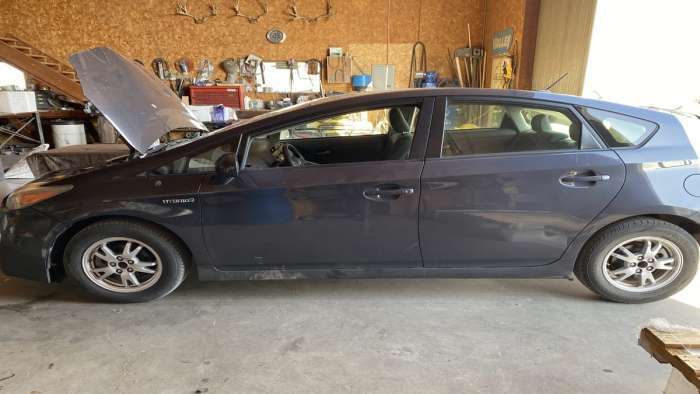If you have not read my other article, Did I make a mistake buying a 2010 Toyota Prius?, make sure you read that. It will help answer some questions you may have.
I have been dealing with hybrids now for quite some time. I have now owned nine hybrids. I have had 6 Prius and 3 Honda Civic Hybrids. Why would anyone own so many hybrids? Great question. I do it to learn so that I can help other people with their hybrids.
I had a lot of experience with Gen 2 Prius, but with Gen 3, I felt like a hypocrite not owning one but giving advice. Granted, I know enough about Gen 3 to guide any owner in the right direction safely, but I needed to have one for myself.
After searching everywhere, I finally came across one locally that needed some engine repair work. Many times the early Gen 3 Prius can be found with a lousy head gasket and picked up for cheap. This Prius was one of those.
After an initial inspection of the car, I found the critical signs to a blown head gasket. Coolant and oil mixed, knocking on startup, and losing coolant in the expansion tank. I knew that this was a common issue and did some research on what the best method of repair would be.
After exploring and researching, I had two options. Replace the head gasket or replace the engine. Here is what I learned from this experience and what I ended up doing.
Your Gen 3 Prius May Need An Engine Replacement
I spent a decent amount of time talking to other hybrid repair technicians. These guys have done many repairs on Gen 3, and all of them told me that just replacing the head gasket is a precarious move.
I have been wrenching for 15 years now and needed a deeper explanation of why this is. What was explained to me is that when the head gasket starts leaking into the cylinder, the liquid coolant has to be expelled somehow. On startup, this coolant cannot be compressed in the engine, and so what happens is this puts extra strain on the connecting rod and usually bends the rod. Thus killing the entire engine.
I was devastated when I found this out, but also it made sense to me. It was at this point I had to decide to either roll the dice and repair the head gasket or replace the entire engine. Replacement of the engine was something I did not want to do. I buy these cars for research, then once they are back to 100%, I sell them and move on. Hence, owning nine hybrids.
Your Prius may not need an engine; it depends on how long the issue has been going on. You will not know that until you pull the head and find out. That was my next step, and what I found out shocked me.
What I Found Upon Pulling The Head On My 2010 Prius
One of my hybrid friends who had been down this road before gave me some excellent guidance once I was able to get the head pulled from the car.

He told me to check the depth of each piston compared to the one next to it. If I have a bent connecting rod, the measurements will not be the same. I dug in, pulling everything apart, and what I found was rather surprising. After pulling the head off and measuring the piston depth, mine were all fine. This comparison should be any owners deciding factor on what to do.
The reason this blew me away is that the Prius had been drinking coolant, the engine oil alone proved that. I decided at this point that if there were something I was missing, I would find out once the engine was back together.
I cleaned up all the parts as best I could, and reassembled the car.
The Aftermath Of Repairing the Prius Head Gasket
I was very nervous about turning the car on after the repair. Even though the block and the head are straight, the valves were seating, and I had gone exactly by the book, I still quivered.
The Prius rattled to life as oil pressure built up within the first few seconds of run time, and then it smoothed out and was quiet. I was very apprehensive about driving it, but I knew I needed to make sure the repair was trustworthy.

I gave the Prius a quick 5-mile test run down the local fuel station and picked up a soda for myself. Quiet, smooth, everything in order. Everything seemed okay until on the return trip. Check engine light. Lucky for me, I always carry my code reader with me on test drives.
I plugged in and saw a P0401, EGR Insufficient Flow Detected. Having this code is crazy because I cleaned every port and passage on the cooler and piping, so there should be no issue at all.
Other than that, I have had no problems at all with the Prius from the engine. It is running well, smooth, and quiet.
Conclusion
I think I got fortunate with this job. As stated before, I spoke with many different technicians about this repair before I ever attempted it. I knew the risks of only doing a head gasket. I knew to check for a bent connecting rod; I knew to flush the engine, clean the EGR system, and all the small things in between. I have been working on cars for 15 years now, so my experience doing this was straight forward.
I think that someone who can follow the OE procedures to do this repair can do it. I also believe that you are taking a considerable risk, only replacing the head gasket. My 2010 has 211,000 well-abused miles on it. I could instantly tell that the previous owners did not care about the car. The green coolant that had been run through the car was a big sign of that.
If you want to fix your 3rd Gen Prius head gasket, know the risk you are taking. Many other problems can show up afterward once the repair has been done. Other problems may not happen until thousands of miles down the road.
So, I think the question now is, Did I make a mistake buying a 2010 Toyota Prius? Time and miles will tell all, but for $500 and some of my time, I think for me, it was worth it. I learned a lot, even more than what I have shared with you here today.
If you have questions or want to discuss doing a head gasket repair on your 3rd Gen Toyota Prius, let me know I am happy to chat with you about it. Hit me up on Twitter or find me on Facebook. I am glad to share my knowledge on hybrids and save you money. See you in the next story. How Long Do Toyota Prius Engines Last?
Watch this Toyota Prius truck with a nice little bed and click to subscribe to Torque News Youtube for daily automotive news analysis.
Peter Neilson is an automotive consultant specializing in electric cars and hybrid battery technologies. He holds a Bachelor of Science in Automotive Service Technology from Weber State University. Peter is also an Instructor of Automotive Technology at Columbia Basin College. Peter can be reached on Linkedin and you can tweet him at The_hybrid_guy on Twitter. Find his page on Facebook at Certified Auto Consulting. Read more of Peter's stories at Toyota news coverage on Torque News. Search Toyota Prius Torque News for more in depth Prius coverage from our reporters.













Comments
You reference trouble with
Permalink
In reply to I was told by a local by Jeff VanHoy (not verified)
You reference trouble with the camshaft assembly but I'm wondering whether you have trouble with the rocker/valve cover? If you're not getting a uniform gap on the cover, there are only three possible problems. First, the cover is bent. 2nd, the cylinder head is bent. Third, something is hitting or obstructing the inside of the valve cover. Check the cover and head for flatness. Check for obstructions.
Also, before putting the cover back on or putting spark plugs back in, I'd rotate the motor through at least 2 complete revolutions gently to make sure there are no obstructions. Then, I'd make sure each cylinder is making compression (either do a leak down test or place a balloon on each of the plug tubes and make sure it partially inflates on rotation). The valve train must function correctly and move freely. If any part of the camshaft or valve train is obstructing the cover, that must be addressed.
If after checking these issues you can't get the cover on completely (it should seat completely flat with or without RTV on the head) I don't know what to tell you. Except, go to the local Pick-A-Part and get a motor. (150 to 300 bucks) Look on Row52.com. Look for a smashed up Prius with the same code on top of the block and double check under the oil cap that there isn't a milkshake appearance inside. Even a smashed front end will work...I've pulled probably 5 motors and never found a cracked block. Go around the motor with a large wire clipper or cordless sawzall and cut everything connected but leave the injector wiring intact. Then, pull bottom center motor mount (THIS IS THE FIRST MOTOR MOUNT TO REMOVE), cut or disconnect driveshafts, disconnect other motor mounts and the whole drive train will roll forward and down. I can do this in about 40 minutes by myself but it may take you longer if you've not done it before. You can also remove just the ICE from the top and there's only about an eight of an inch to spare. The drive train needs to be tilted upward slightly after the passenger motor mount is disconnected. You might want to remove yours first for practice. Just be SURE to label each wire and hose as you do. I like to use plastic shopping bags to put bolts and nuts in and then tie the bag to the part related to it. If the motor has to come out anyway, no harm done. I'd definitely consider a used motor off of eBay as well or from a local junk yard. These motors will go 300K if properly taken care of. Definitely be looking at Priuschat.com during this process. If those guys don't have the answer, you won't find the answer.
I just wrote something on
Permalink
In reply to I was told by a local by Jeff VanHoy (not verified)
I just wrote something on this but it might have disappeared. Anyway, I've not heard your issue before but I would suggest you sign up at priuschat.com. Very good expertise there. Also, be aware of the bent piston rod possibility after a Prius head gasket issue. It's best to measure piston height before replacing the head but I think you could do that after head replacement as well. Make sure the valve cover and top of the cylinder head are flat and there's no obstruction when replacing the cover. On the RTV, there's also an oil passage in the timing cover and if you don't get RTV to surround that passage, you'll have instant coolant/oil mixing. Consider a junkyard or eBay engine if the head gasket repair doesn't work. If you can replace a cylinder head, you can replace the engine.
I can't get my comments to
Permalink
In reply to I was told by a local by Jeff VanHoy (not verified)
I can't get my comments to post correctly.
Either the mating surfaces
Permalink
Either the mating surfaces are not flat or the valve cover is hitting something. The gap should be consistent and not require clamps. Make sure you get RTV around the oil passage in the timing cover or you'll mix the oil and coolant. If you can use a side looking inspection camera so see the cylinder walls, make sure there is no polishing on the sidewall of the prior bad cylinder. That means a piston rod was bent during the gasket failure. Used motor from ebay or row52.com is between 150 and 400 or so. If you can get this far with the cylinder head, there's no reason you can't pull the motor, but you might have to get an engine hoist at harbor freight or rent one.
Did you machine the head? And
Permalink
Did you machine the head? And if so did you have to accommodate the difference in thickness with a different head gasket?
I don't believe any thicker
Permalink
I don't believe any thicker head gaskets are available. I think I've done it with and without machining. In one case, I had trouble removing the head as one of the EGR studs was not removed and I made some scratches in it. Machining fixed that. If you check for flatness and it's within spec, I doubt machining would be required. I believe there's also a min head thickness so check that if machining. I'd turn it upside down and if it won't leak gasoline past the valve seats, I wouldn't worry much. Maybe check for cracks.
I would like to discuss use
Permalink
I would like to discuss use of Bars Leaks to correct minor head gasket problems. I was a non-believer in use of engine coolant additives, but i tried it in my prius and would like to discuss results with you.
I'm fine discussing this
Permalink
I'm fine discussing this although not an expert on this specific aspect of the Prius. The motor is either a 1.5 or 1.8l 4 cylinder that's also used on a number of gas-only Toyotas, Scions, etc. Therefore, any leak sealant that would work on such a motor could work. I'd look around on Priuschat.com. One person used it and had a catastrophic failure (total engine loss) several months later. This may have been caused by hydro-locking and if you've had any hard starts, you've probably hydro-locked yours and maybe bent a connecting rod. Then, it might be only a matter of time before total failure, regardless of how you stop the leak.
Don Hiebert
8057978374
Hey been a mechanic for
Permalink
In reply to I'm fine discussing this by Don Hiebert (not verified)
Hey been a mechanic for fourteen years worked with my dad since I was fifteen after highs school 50 to 80 hrs ever since shop/rape key finally kicked me off for not paying because October 13 my dad passed our incredible name on the beach will stand im great and technologically advanced and we spared no expense. Probly no one will read this way to long I can remember the last thing there was a break in procedure I think it said start let run no more than ten min turn off full cool down start run know less than 15 min or just 15 min and then break in completely also race turbo hayabusa and we let em idle heat and cool a few time ride around a mile or two and let her rip no matter fully rebuilt or not those are bad ass race parts that can do that though
If the Toyota extended life
Permalink
If the Toyota extended life coolant gets into the oil, the acidity can ruin the bearings. Best case scenario, and it’s common, is no coolant in oil just a bit in the cylinder causing a misfire. Head gasket repair will fix this. If their is coolant in the oil, the engine may fail down the road and the head gasket repair only serves to getvto that point.
This is a helpful article…
Permalink
This is a helpful article with a lot of comments that I stopped reading after the first page, so I do not know if anybody has previously suggested the following simple workaround/troubleshooting method. My 2011 Prius developed this issue at around 205,000 miles: it would run rough when starting but after a couple of seconds would be fine. It was showing misfire codes. After learning about the head gasket problem and the rough startup being due to coolant being forced into the cylinder through a leaking head gasket, I figured this was only a problem when the cooling system was pressurized after driving. The coolant recovery tank is pressurized, so I started loosening the cap after driving to depressurize it. As long as the engine is not overheated, there is no danger of scalding because the tank is not full to the cap. I leave the cap loose until the next trip and loosen it after every trip. I also put a cheap $3.00 ELM327 code reader on the OBDII port so I can read the coolant temperature on my phone and it has never overheated after 6,000 miles of driving and always starts and runs find and is throwing no codes. So not only is this a workaround that works indefinitely as long as you do not mind the hassle of loosening and tightening the coolant recovery tank cap, but there is no doubt that my engine is fine and is not overheating, so it would be worth replacing the head gasket. That said, I only use the car locally and I would definitely replace the head gasket before making a long trip and I plan to anyway when I get the time.
I have a Prius Plug-in 2014…
Permalink
I have a Prius Plug-in 2014 with about 73K miles (engine+transmission replaced at about 108K or 112K miles, Headgasket replaced at 212K or 208K miles, going strong ~ 340k miles now) and Prius V 2013 with about 173K miles (started engine rattle about 10K later, replaced ignition coils from junkyard, went OK for a few 1000 miles before rattling again).
Pulled the engine for the V at 187350 miles, and teared it down, replaced rings and pistons and head gasket from dealer. Only driven it a few hundred miles. So far, so good. Plan on changing engine oil at 500,1000 and once more before defaulting to 5k intervals.
Pagination